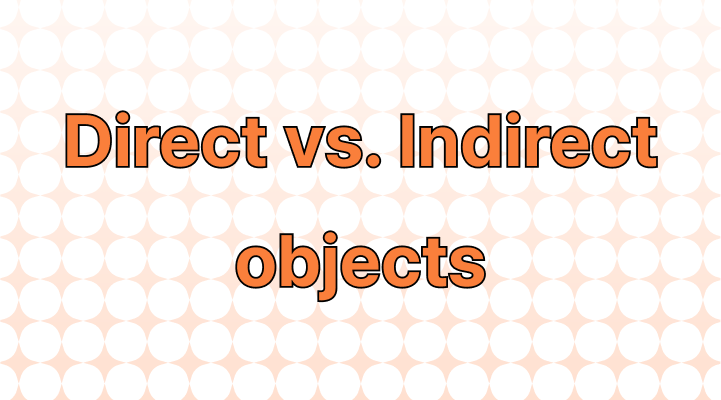A direct object is a noun or pronoun that receives the action of the verb in a sentence like "She bought a book." Here, the direct object is "a book," as it receives the action of the verb "bought."

Direct objects and indirect objects play pivotal roles in sentences, conveying essential information about the action and the recipient. A direct object directly receives the action of the verb, while an indirect object indicates to or for whom or what the action is done. Let's explore the distinctions between these two types of objects and delve into their usage.
Direct objects
Direct objects, denoted by direct object nouns (book, apple, glasses) or pronouns (it, him, her, them) receive the action of the verb directly. For instance, in the sentence "He ate an apple," "an apple" is the direct object, as it answers the question "What did he eat?" Here are a few more examples with the direct objects in bold:
He dropped the phone.
They watched the movie.
She saw him yesterday.
Indirect objects
On the other hand, indirect objects, often represented by pronouns such as "me," "him," "her," "us," or "them," receive the action indirectly and typically answer the questions "to whom" or "for whom" the action is done. Consider the sentence "He gave her a gift." Here, "her" is the indirect object (while "gift" is the direct object), indicating the recipient of the gift. Additional examples include:
She baked him a cake.
In this example above, "him" is the indirect object who receives "a cake," the direct object.
They offered us some help.
Here, "us" is the indirect object who was offered "some help," the direct object.
He sent her a letter.
In this sample sentence, "her" is the indirect object who was sent "a letter," the direct object.
More direct and indirect objects in the same sentence
In certain sentences, both direct and indirect objects may be present (such as the last three example sentences), allowing for more nuanced expressions. For instance, in the sentence "She bought him a book," "a book" serves as the direct object, while "him" functions as the indirect object, indicating the recipient of the purchase. Here are further illustrations:
They made her a cup of tea.
The direct object here is "a cup of tea" while the indirect object is "her," the person who received the cup of tea.
I wrote my friend a letter.
In this sentence, "a letter" is the direct object while "my friend" is the indirect object, the person who received the letter.
He taught the students a lesson.
Here, the direct object is "a lesson," and the indirect object is "the students," the recipients of the verb "taught."
Direct and indirect pronouns
When replacing objects with pronouns, direct object pronouns precede the conjugated verb, while indirect object pronouns usually come before the conjugated verb and after the preposition. For example, in the sentence "She bought it for him," "it" is the direct object pronoun, and "him" is the indirect object pronoun. Examples of sentences featuring both types of object pronouns include:
He gave it to her.
In this example, "it" is the direct object pronoun while "her" is the indirect object pronoun, the person who received the direct object.
They sent them to us.
In the above sentence, "them" is the direct object pronoun being delivered to "us," the indirect object pronoun.
She showed it to him.
In this sentence here, "it" is the direct object pronoun, and "him" is the indirect object pronoun, the person who is being shown the "it."
Practice sentences
Identify the direct objects and indirect objects of each sentence. The answers are at the end of this article.
- She gave him the book.
- They sent us an invitation.
- She gave it to him.
- I made them a cake for their birthday.
- The teacher assigned us some homework.
- He showed them to us.
- She asked him a question.
- They offered us some help with the project.
- He told her a secret.
- I brought them some snacks for the trip.
Understanding the distinctions between direct and indirect objects, as well as their respective pronouns, enhances one's grasp of sentence structure and communication in various contexts. By mastering these concepts, individuals can express themselves more effectively and precisely in both spoken and written language.
Answers to the practice questions:
- Direct object: the book; Indirect object: him
- Direct object: an invitation; Indirect object: us
- Direct object: it; Indirect object: him
- Direct object: a cake; Indirect object: them
- Direct object: some homework; Indirect object: us
- Direct object: them; Indirect object: us
- Direct object: a question; Indirect object: him
- Direct object: some help (with the project); Indirect object: us
- Direct object: a secret; Indirect object: her
- Direct object: some snacks (for the trip); Indirect object: them

Want to sound like a native speaker?
Engram’s AI-powered grammar checker makes your English sound like a native speaker’s, suggesting natural English expressions on top of fixing grammar, spelling, punctuation, word order, and vocabulary.














